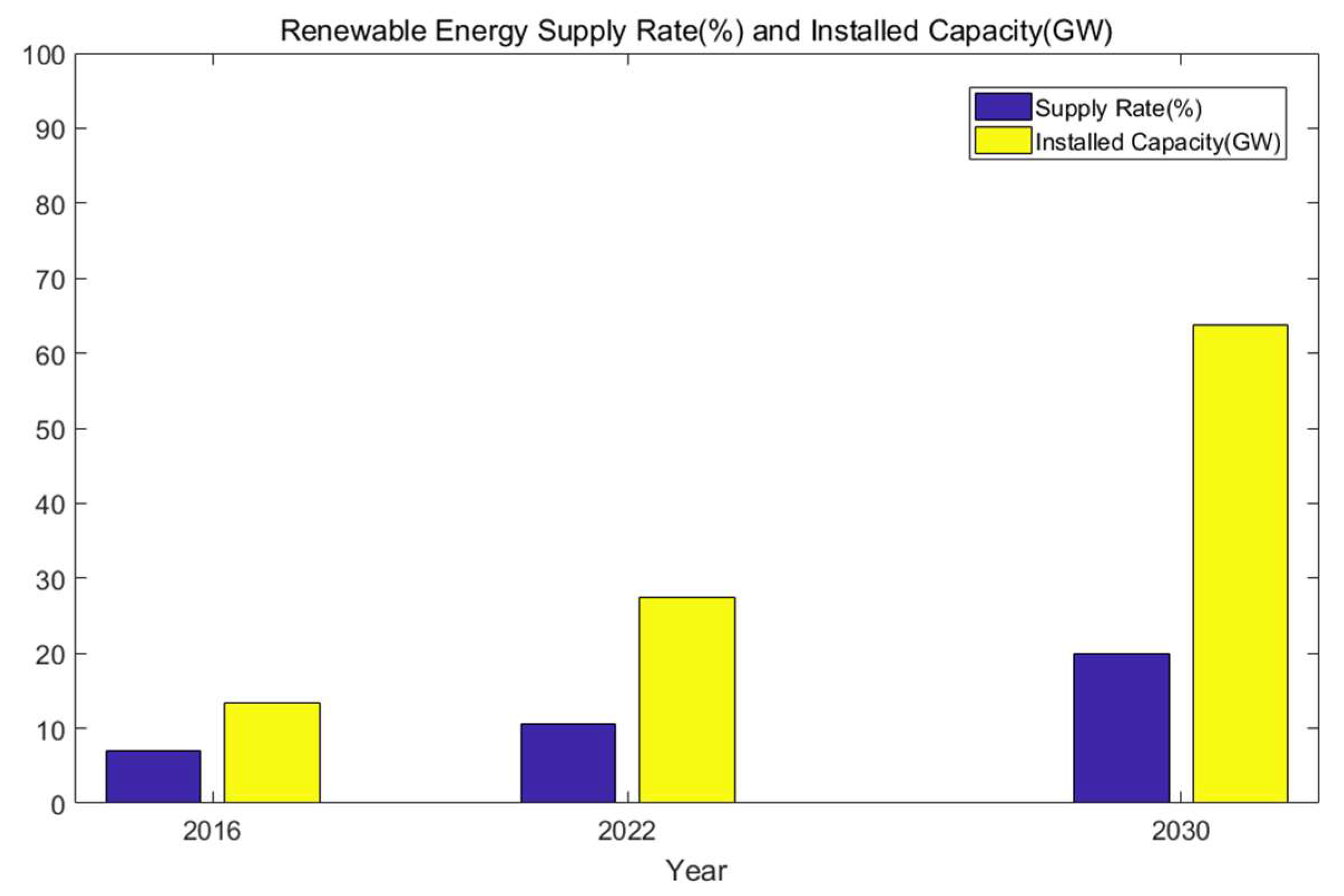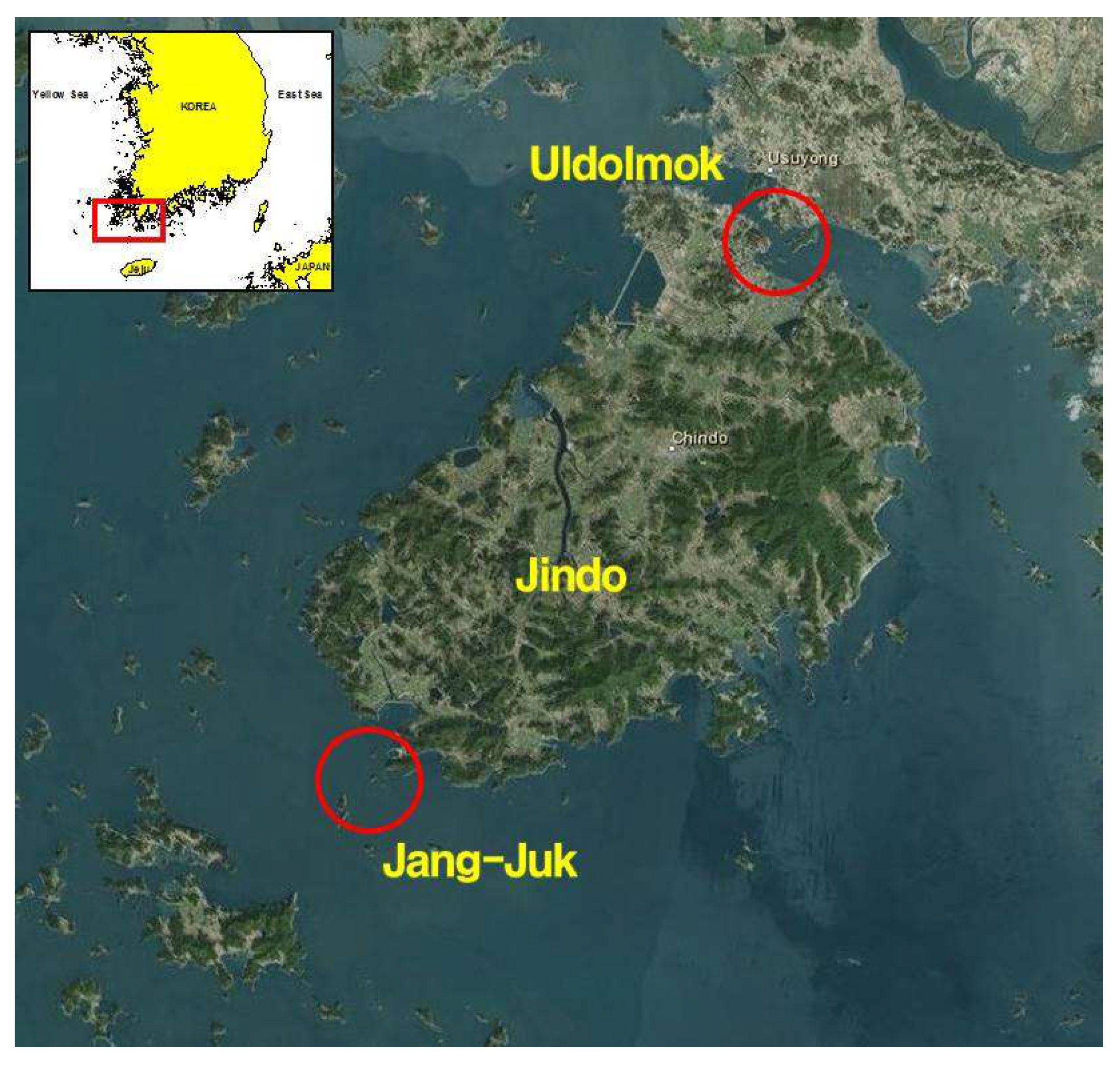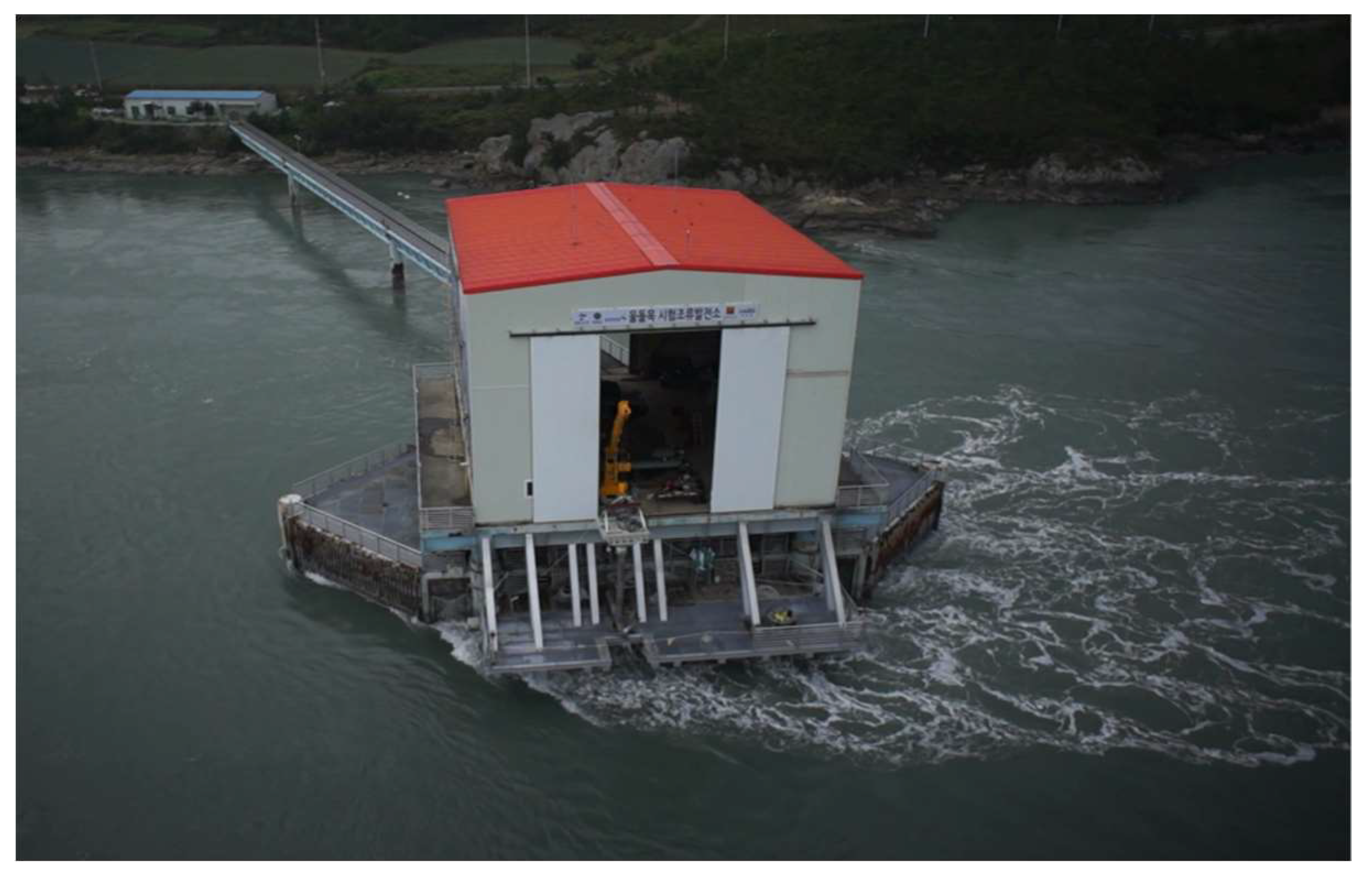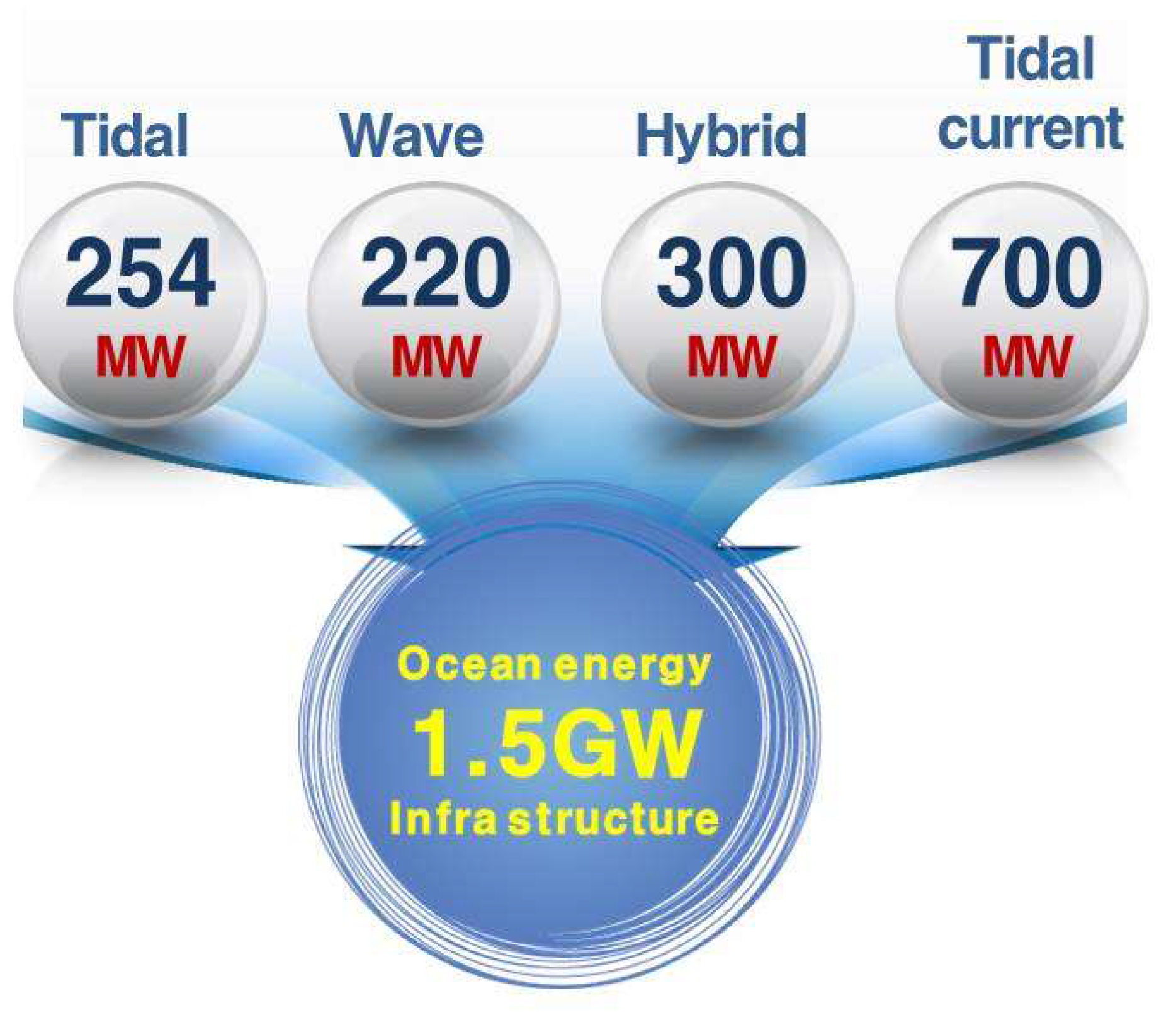Current Policy and Technology for Tidal Current Energy in Korea
Abstract
:1. Introduction
2. Ocean Energy Policy
2.1. Situation of National Power Supply
2.2. National Energy Policy and Strategy
- Strategy 1: Expansion of R&D in ocean energy and establishment of real sea test bed.
- Strategy 2: Construction of large-scale ocean energy farm.
- Strategy 3: Enter the global market and expand domestic supply.
- Strategy 4: Establishment of certification system and strengthening of policy support.
- Strategy 1: Promote marine fisheries, science and technology to create new industries and jobs.Specifically, cultivate the following five sectors because they are expected to be industrialized soon: ocean energy, ocean bio, marine equipment and robots, eco-friendly vessels and aquaculture.
- Strategy 2: Establish marine science and technology base to address and solve social problems.
- Strategy 3: Innovate a new research and development support system by the Korean government.
- Strategy 4: Create an ecosystem for sustainable development of marine fisheries, science and technology.
2.3. Market Incentive
3. Technology Status of TEC
3.1. Uldolmok Tidal Current Power Pilot Plant
3.2. Active-Controlled TEC
3.3. Tidal Current and Pumped Storage Hybrid Power Generation
- (1)
- The development of design technology for the tidal current and pumped storage hybrid power generation system.
- (2)
- The execution of indoor and outdoor experiments for the tidal current-pumped storage hybrid power generation system with an emphasis on demonstrating the feasibility of using the storage tank for aquaculture.
4. Open Sea Test Bed for TEC
5. Conclusions
- (1)
- Uncertainty of consent and low public acceptanceIn case of Korea, developers have to gain consents such as environmental assessment, use of public water and maritime traffic safety assessment from local governments or the central government. Approval is not easily obtained because the public acceptance is low in Korea. Therefore, it is necessary to develop ocean energy using bottom-up approaches such as the participation of local residents or local government. Moreover, the consent procedure must be simplified and suggestions for cultivating coexistence with existing users of project sites, such as fisheries and tourism.
- (2)
- Marine environmental impact assessment for ocean energy development projectTo develop ocean energy projects, it is necessary to review and evaluate the project through an environmental impact assessment. However, the environmental impact assessment items are not specific and there are no items that focus on different types of project. The inability to verify mitigation methods presents another challenge. It is also necessary to systematize a post-construction monitoring and maintenance plans. Finally, the efficacy of the evaluation system must be strengthened by identifying and incorporating specific and important items for environmental impact assessments.
- (3)
- Establishment of the supply chain systemTo promote ocean energy industrialization, it is essential to establish a supply chain system. Although options are limited for promoting the ocean energy industry, a cluster would enhance the industrial structure and the competitiveness of participating enterprises.Unfortunately, there are many difficulties in establishing a supply chain in the early stages of technology due to the absence of ocean energy industry infrastructure. Therefore, during the early stages, it is necessary to bolster market potential through R&D activities and by establishing the infrastructure. After that, the creation of the ocean energy industry must be induced by integrating related companies through the establishment of a pilot array in the medium term. This would then encourage the participation of private companies and thus facilitate the establishment of a supply chain through the construction of large-scale power generation farms. Moreover, it is judged that strategies such as securing REC weights must also be strengthened to secure further investment by private companies.
- (4)
- Technical standards and certification for ocean energyThe International Electrotechnical Commission (IEC)’s technical committee (TC) 114 (IEC TC-114) has published the 62,600 series of Technical Specification (TS) for ocean energy so as to support risk minimization and secure the reliability and stability of ocean energy converters. An open sea test bed for tidal current energy converters, which is under construction, will enable performance testing and evaluation. Additionally, a certification system would help dissolve trade barriers between countries and induce entry into overseas markets.
Author Contributions
Funding
Conflicts of Interest
Nomenclature
| FIT | Feed in Tariff |
| IEA | International Energy Agency |
| IEC | International Electrotechnical Commission |
| KERI | Korea Electrotechnology Research Institute |
| KETEP | Korea Institute of Energy Technology Evaluation and Planning |
| KIOST | Korea Institute of Ocean Science and Technology |
| KOLAS | Korea Laboratory Accreditation Scheme |
| K-TEC | Korea Tidal Current Energy Center |
| MOF | Ministry of Oceans and Fisheries |
| MOTIE | Ministry of Trade, Industry and Energy |
| OTEC | Ocean Thermal Energy Conversion |
| PMSG | Permanent Magnet Synchronous Generators |
| REC | Renewable Energy Certificate |
| RPS | Renewable Energy Portfolio Standard |
| TEC | Tidal Current Energy Converters |
| TC | Technical Committee |
| TRL | Technology Readiness Levels |
| WEC | Wave Energy Conversion |
References
- Mestres, M.; Griñó, M.; Sierra, J.P.; Mösso, C. Analysis of the optimal deployment location for tidal energy converters in the mesotidal Ria de Vigo (NW Spain). Energy 2016, 115, 1179–1187. [Google Scholar] [CrossRef]
- Korea Energy Agency. Status and forecast of national energy. In 2018 New&Renewable Energy; Ministry of Trade, Industry and Energy (MOTIE): Sejong, Korea, 2018; pp. 58–59. [Google Scholar]
- Lee, M.E.; Kim, G.; Jeong, S.-T.; Ko, D.-H.; Kang, K.S. Assessment of offshore wind energy at Younggwang in Korea. Renew. Sustain. Energy Rev. 2013, 21, 131–141. [Google Scholar] [CrossRef]
- Kang, S.K.; Foreman, M.G.G.; Lie, H.-J.; Lee, J.H. Two-layer tidal modeling of the Yellow and East China Seas with application to seasonal variability of the M2 tide. J. Geophys. Res. 2002, 107, 3020. [Google Scholar] [CrossRef]
- Hong, K.; Hyun, B.-S. Current status and prospect of ocean energy technology. Mag. Korean. Soc. Air-Cond. Refrig. 2010, 39, 13–19. [Google Scholar]
- Park, J.-S.; Lee, C.; Park, J.-S.; Choi, H.-W.; Ko, D.-H.; Lee, J.-L. Assessment of tidal stream energy resources using a numerical model in southwestern sea of Korea. Ocean Sci. J. 2019, in press. [Google Scholar]
- The Korean Society of Ocean Policy (KSOP). Maritime Fisheries Technology Level Analysis Report; KIMST: Seoul, Korea, 2017; p. 155. [Google Scholar]
- Ministry of Trade, Industry and Energy (MOTIE). 8th Basic Plan for Electricity Supply and Demand in Korea; MOTIE: Sejong, Korea, 2018; pp. 1–80.
- Ministry of Trade, Industry and Energy (MOTIE). 3020 Plan for Development of Renewable Energy; MOTIE: Sejong, Korea, 2017; pp. 1–9.
- Ministry of Oceans and Fisheries (MOF). 2030 Plan for Development of Ocean Energy; MOF: Sejong, Korea, 2017; pp. 1–21. [Google Scholar]
- Ministry of Oceans and Fisheries (MOF). The Strategic Plan for Development and Support of New and Renewable Energy Such as Ocean Energy; MOF: Sejong, Korea, 2017; pp. 1–19. [Google Scholar]
- Ministry of Oceans and Fisheries (MOF). Basic Plan for the Marine Fisheries, Sciences and Technology Promotion; MOF: Sejong, Korea, 2018; Available online: https://www.kimst.re.kr/u/rnd/rnd/content.do (accessed on 18 March 2019).
- National Law Information Center. Marine Environmental Impact Assessment Act (Act No. 15662); Ministry of Government Legislation (MOLEG): Sejong, Korea, 2018. Available online: http://www.law.go.kr/lsInfoP.do?lsiSeq=203758&efYd=20181213#0000 (accessed on 18 March 2019).
- Lee, D.I.; Kim, G.Y.; Tac, D.H.; Yi, Y.M.; Choi, J.H.; Kim, H.J.; Lee, J.H.; Yoon, S.S. Diagnosis of scoping and type of review on the marine environmental impact assessment for ocean energy development project. J. Korean Soc. Mar. Environ. Energy 2015, 18, 179–188. [Google Scholar] [CrossRef]
- National Law Information Center. Framework Act on Marine Fishery Development (Act No. 14804); Ministry of Government Legislation (MOLEG): Sejong, Korea, 2018. Available online: http://www.law.go.kr/lsInfoP.do?lsiSeq=193434&efYd=20171019#0000 (accessed on 18 March 2019).
- National Law Information Center. New Energy and Renewable Energy Development, Use and Spread Promotion Law (Act No. 14670); Ministry of Government Legislation (MOLEG): Sejong, Korea, 2018. Available online: http://www.law.go.kr/lsInfoP.do?lsiSeq=192510&efYd=20170922#0000 (accessed on 18 March 2019).
- National Law Information Center. Energy Act (Act No. 15344); Ministry of Government Legislation (MOLEG): Sejong, Korea, 2018. Available online: http://www.law.go.kr/lsInfoP.do?lsiSeq=201155&efYd=20180417#0000 (accessed on 18 March 2019).
- National Law Information Center. Framework act on low carbon green growth (Act No. 16133); Ministry of Government Legislation (MOLEG): Sejong, Korea, 2018. Available online: http://www.law.go.kr/lsInfoP.do?lsiSeq=206348&efYd=20190401#0000 (accessed on 18 March 2019).
- National Law Information Center. Rational Energy Utilization Act (Act No. 15574); Ministry of Government Legislation (MOLEG): Sejong, Korea, 2018. Available online: http://www.law.go.kr/lsInfoP.do?lsiSeq=203183&efYd=20181018#0000 (accessed on 18 March 2019).
- Ocean Energy Systems (OES). An Overview of Activities in 2017, Annual Report; OES: Lisbon, Portugal, 2017; p. 96. [Google Scholar]
- Byun, D.S.; Hart, D.; Jeong, W.J. Tidal current energy resources off the south and west coasts of Korea: Preliminary observation-derived estimates. Energies 2013, 6, 566–578. [Google Scholar] [CrossRef]
- Korea Hydrographic and Oceanographic Agency (KHOA). A Study on Development of Tidal Current Energy Map(I): Based on Measured Tidal Current Speed; KHOA: Busan, Korea, 2010.
- Ko, D.H.; Park, J.-S.; Lee, K.-S. Assessment of Tidal current energy potential at Uldolmok in the Southwestern coast of Korea. J. Coast. Res. 2018, 85, 1301–1305. [Google Scholar] [CrossRef]
- Lee, K.-S.; Park, J.-S. Natural Energy Produced by the Sea; Korea Institute of Ocean Science and Technology (KIOST): Busan, Korea, 2013; pp. 94–125. [Google Scholar]
- IEC. International Standard, Wind Turbines–Part 3: Deign Requirements for Offshore Wind Turbines, 1st ed.; IEC: Geneva, Switzerland, 2009; pp. 10–15. [Google Scholar]
- Shang, Y. Resilient Multiscale Coordination Control against Adversarial Nodes. Energies 2018, 11, 1844. [Google Scholar] [CrossRef]
- Park, J.-S.; Ko, D.H.; Yi, J.-H. Planning on establishment of sea test-bed for tidal current energy converters in Jindo, Korea. In Proceeding of Asian Wave and Tidal Energy Conference Series 2018; AWTEC: Taipei, Taiwan, 2018. [Google Scholar]










| Energy Resource | REC Weight | Criterion | |
| Type | Detail | ||
| 1.0 | Hydroelectric power, Tidal power (with sea wall) | ||
| 2.0 | Tidal power (no sea wall), Tidal current energy | Fixed type | |
| 1.0~2.5 | Tidal power (no sea wall) | Variable type | |
| 2.0 | Offshore wind (according to grid connection distance) | ≤5 km | |
| 2.5 | >5 km and ≤10 km | ||
| 3.0 | >10 km and ≤15 km | ||
| 3.5 | ≥15 km | ||
| 4.5 | Energy Storage System(ESS) (with wind power) | In 2018, 2019 | |
| 4.0 | In 2020 | ||
© 2019 by the authors. Licensee MDPI, Basel, Switzerland. This article is an open access article distributed under the terms and conditions of the Creative Commons Attribution (CC BY) license (http://creativecommons.org/licenses/by/4.0/).
Share and Cite
Ko, D.-H.; Chung, J.; Lee, K.-S.; Park, J.-S.; Yi, J.-H. Current Policy and Technology for Tidal Current Energy in Korea. Energies 2019, 12, 1807. https://doi.org/10.3390/en12091807
Ko D-H, Chung J, Lee K-S, Park J-S, Yi J-H. Current Policy and Technology for Tidal Current Energy in Korea. Energies. 2019; 12(9):1807. https://doi.org/10.3390/en12091807
Chicago/Turabian StyleKo, Dong-Hui, Jaekwan Chung, Kwang-Soo Lee, Jin-Soon Park, and Jin-Hak Yi. 2019. "Current Policy and Technology for Tidal Current Energy in Korea" Energies 12, no. 9: 1807. https://doi.org/10.3390/en12091807
APA StyleKo, D.-H., Chung, J., Lee, K.-S., Park, J.-S., & Yi, J.-H. (2019). Current Policy and Technology for Tidal Current Energy in Korea. Energies, 12(9), 1807. https://doi.org/10.3390/en12091807






